
Hakea laurina is shrub or small tree commonly known as kodjet or pin-cushion hakea and is endemic to Western Australia. The Noongar name for the plant is kodjet or kojet. It has red and cream conspicuous globular flowers and lance shaped leaves.

Hakea salicifolia commonly known as the willow-leaved hakea, is species of flowering plant that is endemic to eastern Australia. It is an adaptable, fast growing small tree or shrub with attractive foliage and cream white flowers.

Isopogon dubius, commonly known as pincushion coneflower, is a species of plant in the family Proteaceae and is endemic to the south-west of Western Australia. It is a shrub with sharply-pointed, deeply lobed or pinnate leaves and more or less spherical heads of pink to reddish pink flowers.

Kennedia prostrata, commonly known as running postman, scarlet coral pea or scarlet runner is a species of flowering plant in the family Fabaceae and is endemic to Australia. It is a prostrate or twining shrub with trifoliate leaves and usually red flowers.

Zieria aspalathoides, commonly known as the whorled zieria, heath zieria, hairy zieria or heathy zieria, is a plant in the citrus family Rutaceae and is endemic to eastern Australia. It is a heath-like shrub with leaves that appear to be whorled and with pink flowers in groups of three, each with four petals and four stamens.

Dysoxylum rufum is a rainforest tree in the family Meliaceae, found in eastern Australia. It occurs on a variety of different soils and rainforest types. From as far south as Bulahdelah, New South Wales to the McIlwraith Range in far north eastern Australia. The specific epithet rufum refers to the rusty red of the leaf, fruit and flower hairs of this species.

Hibbertia vestita, commonly known as hairy guinea-flower, is a species of flowering plant in the family Dilleniaceae and is endemic to eastern Australia. It is a small shrub with foliage covered with simple hairs, and usually has linear leaves, and yellow flowers with 22 to 43 stamens and many staminodes arranged around three hairy carpels.

Hakea laevipes is a shrub in the family Proteaceae. A widespread species found growing on coastal and tableland locations mainly in eastern New South Wales, with scattered populations in south-eastern Queensland.

Isopogon asper is a species of plant in the family Proteaceae and is endemic to the south-west of Western Australia. It is a low shrub with crowded pinnate leaves and flattened spherical heads of glabrous pink flowers.
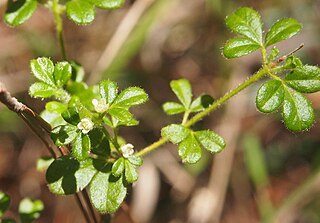
Zieria minutiflora, commonly known as twiggy zieria, is a plant in the citrus family Rutaceae and is endemic to eastern Australia. It is a small, erect, twiggy shrub with leaves composed of three leaflets, and clusters of small white flowers with four petals and four stamens. It usually grows as an understorey shrub in eucalypt woodland.

Zieria caducibracteata is a plant in the citrus family Rutaceae and is endemic to New South Wales. It is a tall shrub or small tree with leaves composed of three lance-shaped leaflets. In early spring there are clusters of small white flowers with four petals near the ends of the branches.

Zieria cytisoides, commonly known as the downy zieria, is a plant in the citrus family Rutaceae and is endemic to eastern Australia. It is a bushy shrub with three-part, clover-like leaves and small clusters of pale to deep pink flowers with four petals and four stamens.
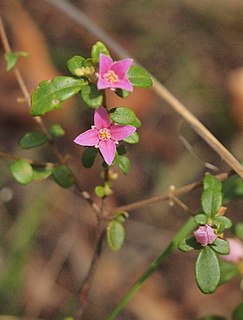
Boronia obovata is a plant in the citrus family Rutaceae and is endemic to the Blackdown Tableland National Park in Queensland, Australia. It is an erect shrub with many branches, leaves usually with three leaflets, and pink, four-petalled flowers.
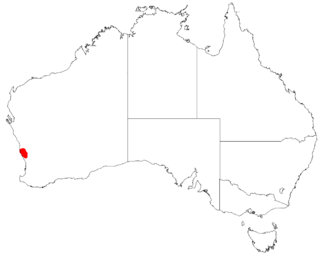
Conostylis angustifolia is a rhizomatous, tufted perennial plant species in the family Haemodoraceae, endemic to the south-west of Western Australia. In September and October it produces yellow flowers in the species' native range.
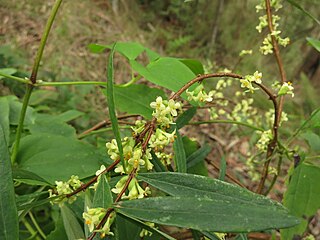
Pimelea axiflora, commonly known as bootlace bush, is a small shrub in the family Thymelaeaceae and is endemic to Australia. It is a small shrub with whitish flowers on mostly smooth stems.

Scaevola parvifolia is an erect, many stemmed perennial in the family Goodeniaceae, which is native to Western Australia, the Northern Territory, Queensland and South Australia. It grows to a height of 0.6 m, and its blue-purple flowers may be seen from March to October.
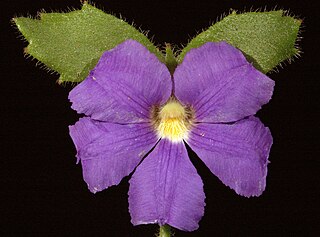
Scaevola pilosa, commonly known as the hairy fan-flower, is a perennial herb in the family Goodeniaceae. It is endemic to the southwest of Western Australia.

Protea burchellii, also known as Burchell's sugarbush, is a flowering shrub in the genus Protea, which is endemic to the southwestern Cape Region of South Africa.

Protea decurrens, also known as linear-leaf sugarbush, is a shrub of the genus Protea, in the Proteaceae family, which is endemic to the southwestern Cape Region of South Africa. It is a small shrub with a thick underground rootstock, this structure throwing up numerous leafy branches, upon the base of which clusters of flower heads may appear close to the ground. It is pollinated by rodents and grows in low-altitude fynbos or renosterveld.

Scaevola parvibarbata is a species of flowering plant in the family Goodeniaceae. It is an upright herb with fan-shaped mauve or greenish flowers and grows in New South Wales, Queensland, South Australia and the Northern Territory.





















